  |  | |||||
| |||||||||||||||
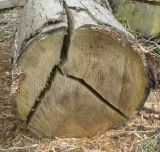 |
|||
The intention of writing this page is to try to help the reader understand the possible problems that may present themselves in attempting to “dry” (season) a large wooden sculpture. It is not intended as a guide to drying sawn timber or timber in general. One of the main problems with large carved wooden sculptures is the tendency they have to crack as they dry out. This cracking is virtually guaranteed with some species of timber and can be exacerbated by the manner in which the sculpture is carved from the parent log. It is important to understand why this happens and, for the carver, how reduce the severity of the problem. In order to be able to anticipate how a sculpture will crack it is necessary to understand what happens to timber as it dries out. The way the timber moves and the stresses that are set up within a log as a result of these movements contribute to the greater or lesser degree of cracking experienced.
|
|||
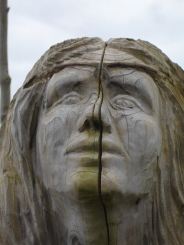 |
A carving ruined. The centre "pith" of the log this was carved from was situated 5cm behind the face. The crack took the shortest distance between the pith and the exposed surface of the timber. |
||
Large scale wooden sculpture is more often than not, carved from a large section log (250mm-1500mm plus, in diameter). In temperate countries like the UK, anything above 250mm dia. and 1000mm long is unlikely to dry out very much in less than two or three years even when under cover. In fact, if the timber is not a naturally durable variety, then it is most likely to rot before it dries out. So very large logs are not going to lose anything like enough moisture to be considered dry or “seasoned within 10 years or more of having been felled. In effect, the sculptor of large logs is always working with what is normally termed “green wood”. If a freshly felled log of around 300mm dia by about 1000mm long is brought indoors to a heated, dry environment.Or, placed out in the baking sun through an extended, hot summer, it goes through a few stages on its’ way to drying out. If it is standing up, then the top end will dry out very quickly to a depth of an inch or so and start to form lots of small cracks radiating out from the centre. The bottom will go damp and mouldy and stain the floor or rot the carpet it stands on. If the log is lying down, then both ends will crack in a similar manner and the floor will mostly escape damage (if it is a round log). A freshly felled log contains a lot of water. Some of this water is “free” water in that it floods all of the spaces in the cells of the timber and is not bonded to anything. When this has evaporated off the “fixed” water is the next to be lost. This fixed water is actually bonded chemically to the material making up the cells; it is part of the structure of the timber. As this water is lost, the wood starts to shrink. On drying out, the wood in the log moves in different ways as it shrinks through loss of “fixed” water. There is very little shrinkage along the length of the log, a fair amount of shrinkage radially, and a lot of shrinkage circumferentially. The circumferential shrinkage can amount to nearly 10%.
| |||
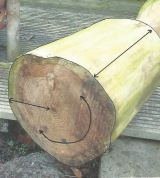 |
The three directions of timber shrinkage on drying out. | ||
The entire log does not lose water at the same rate. The outside of the log, being exposed to the greatest drying influence, will lose moisture very quickly. Especially so if it is in a dry warm room or in direct sunlight. The inside of the log is unable to lose its water as quickly so will resist shrinking. As the outside dries and shrinks, it tries to compress the wet core, which it cannot do, so something has to give way. The outside of the log will split.
| |||
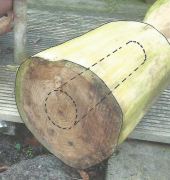 | 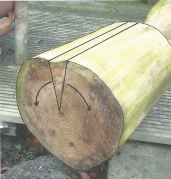 | ||
Wet core
| Typical split
| ||
The wet core is the biggest problem if it is at the “pith” of the log (centremost ring). The timber is trying to shrink, most of all, round this.
So what can be done about the problem?
| |||
| The crack is likely to take the shortest path from the "pith" to the outside of the log. | 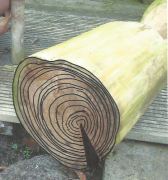 | ||
If it is possible, it is better to create the sculpture from one half of a log that has been split down the middle. In this way the timber is provided with two free faces across the diameter to shrink away from.
| |||
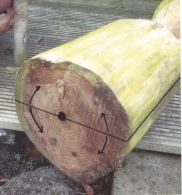 | The black dot in the middle of the line is where the "pith" is to be found. If the log is cut into two halves as indicated by the black line, then the free faces on either side of the pith are able to shrink in the direction of the arrows without cracking the timber. | ||
A very expensive solution might be to purchase a large quantity of sawn, fully seasoned timber, then dress the faces accurately and glue it all together (laminated) to make a large stable block, which is then carved. If the carving can be kept somewhere that stays cool, not too dry, and out of the way of drying breezes, then it will have a chance of losing moisture far slower from the outside layers and thus allowing the moisture in the core more time to move out. This will reduce the drastic difference in moisture content from the middle to the outside of the log, which will in turn reduce the rapid shrinkage of the outside. Which will reduce the size and degree of cracking the timber suffers. Placing the sculpture under some plastic sheeting (though not completely sealed in) can have the same effect. It will also reduce the rate of moisture loss and therefore the cracking. Using sealers, drying oils, varnish etc. to coat the carving can help a lot in forcing it to dry slowly. Though it is still wise to keep it away from direct sunlight and warm rooms. Using oil sealers such as Danish oil and teak oil are often the only choice of moderating the cracking in “stump” carvings (sculptures created from the remaining stem of a tree that has been topped but is still rooted to the ground). These types of carvings are best created in autumn. In this way the sun is less likely to dry them out too fast. They will usually continue to dry over winter, unless the weather is unusually wet, and they get the chance of acclimatising over the whole of spring too. So by the time summer comes they have already lost a considerable amount of moisture and are less likely to crack as badly. Another way of reducing the likelihood of catastrophic cracks on the front of a sculpture is by slitting it down the back with a chainsaw all, or most of the way, to the centre (pith) of the log. Referred to as a stress relief cut.
| |||
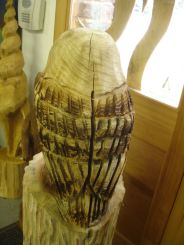 | Stress relief cut in the back of an owl. The side of a sculpture least likely to be looked at. It can be seen that there are drying cracks developing from the stress relief cut. | ||
Timber from tree surgery jobs is often the type worked on by the average chainsaw carver. This is sometimes a big advantage. These logs are usually from fairly open grown trees that have a lot of side branches. These side branches create lots of live knots (don’t want dead, rotten holes). This can help lock a log together making it less likely that large cracks will open up in the first place. The chainsaw carver is well placed to use such timber; no-one else usually wants it. The sawmills won’t take it because when it is all sliced up, the boards and beams will all warp and twist due to all the knots. The firewood merchant is unlikely to want it because it’s big and very hard to split. Is there any wood that won’t split? Some to be wary of: Resistant to splitting:
| |||
Additional points to be aware of. | |||
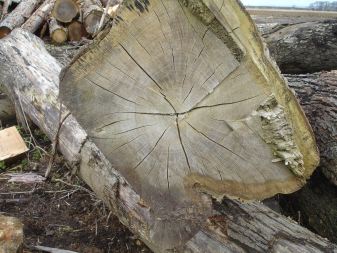 | 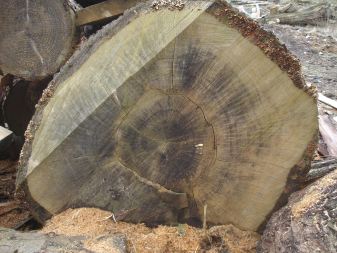 | ||
Star shake
| Ring shake
| ||
| |||
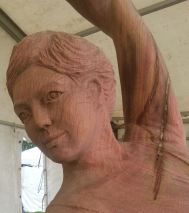 | 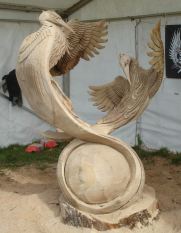 | ||
|
| ||
Sweet Chestnut is a wonderful timber. It is great to carve, has a high proportion of heartwood, and is naturally durable. However, UK grown Sweet Chestnut is very prone to a defect referred to as “ring shake”. Ring shake is a condition in which there is a separation of the annual rings in the heartwood of the tree. This separation can be along one annual ring boundary and extend for only a short segment, or it can affect several annual rings as well as extending around the whole circumference of the log. It is sometimes also hard to spot in a freshly cut log end. It is a serious defect for the carver as it can lead to whole sections of a carving falling away from the core log, often completely unexpectedly. The condition is so common that Sweet Chestnut rarely sells at as high a price as oak even though it is just as resistant to rot. If the timber is sawn into boards the boards will tend to fall to pieces, due to these shakes running through the log. The problem can also be occasionally found in oak.
| |||
 | 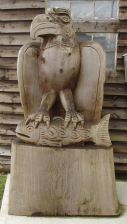 | ||
A carving by Nansi Hemmings. Carved within a half log. There are no serious cracks to be found on this carving anywhere. | |||
Surface cracking This is a less intrusive form of cracking that occurs in most timber exposed to the weather over a few years. It takes the form of fine cracks all over the surface of the timber. Commonly seen on old bits of driftwood lying above the high water mark. On timber that has no oil, paint or varnish finish it can add to the natural look of wood. If however the intention was to preserve the colour and grain of the wood, it can be a problem. The reason it happens is that the surface of the wood is constantly moving as it is the part most exposed to wetting, heat from the sun, and drying winds. It can happen even if the wood is sealed with varnish or resin as these coatings can be degraded by UV from the sunlight.
| |||
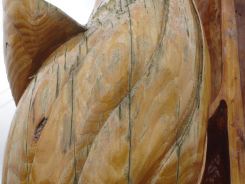 | 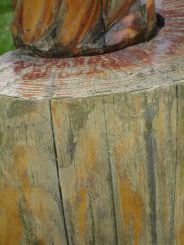 | ||
This is an epoxy and polyurethane finish (marine grade) on a sculpture carved from Douglas Fir. The finish was applied 5 years previously. The sculpture has been exposed to strong sunlight and all weather since then. | |||
In the pictures above, the moisture has created cracks in the finish and the water has got underneath around the fine cracks. The cracks no longer move very much as the timber has reached a bit of a balance with it's environment. This would be a good time to strip the whole sculpture of it's finish and sand it to a fine surface. As the wood is now more stable, a similar finish of marine grade resin and varnish, would likely have a far longer life.
| |||